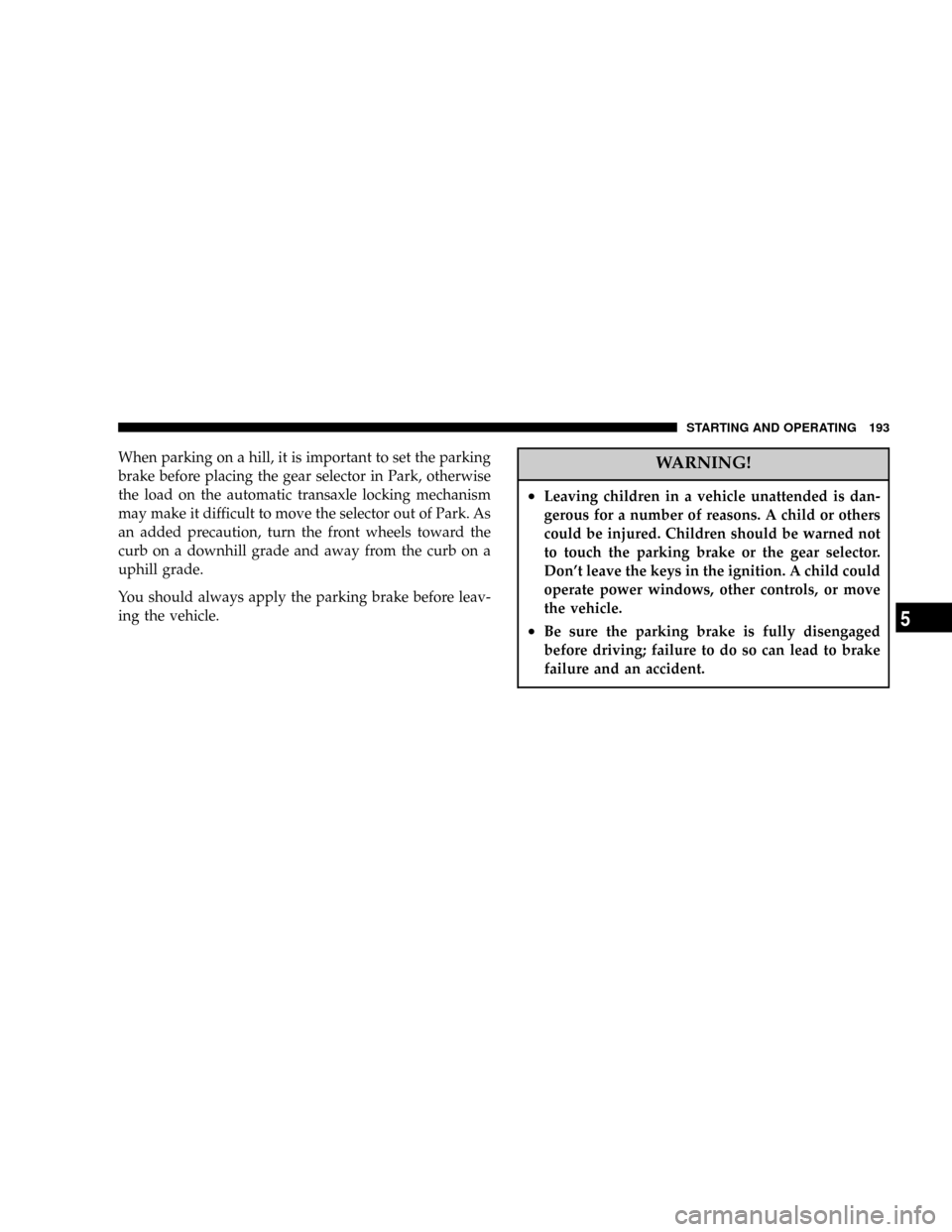window CHRYSLER PT CRUISER 2004 1.G Owner's Manual
[x] Cancel search | Manufacturer: CHRYSLER, Model Year: 2004, Model line: PT CRUISER, Model: CHRYSLER PT CRUISER 2004 1.GPages: 341, PDF Size: 5.06 MB
Page 172 of 341

Window Fogging
Vehicle side windows tend to fog on the inside in mild
rainy or humid weather. To clear the windows, use the
A/C, PANEL and blower controls. Direct the panel
outlets toward the side windows. Do not use recirculate
without A/C for long periods as fogging may occur.
Interior fogging on the windshield can be quickly re-
moved by using the defrost position.
If the fogging problem persists, clean the inside window
surfaces. The cause of undue fogging may be dirt collect-
ing on the inside surface of the glass
NOTE:In cold weather, the use of the recirculate
position will cause windows to fog on the inside because
of moisture build up inside the vehicle. For maximum
defogging, use the Outside Air position.
Summer Operation
Air conditioned vehicles must be protected with a high-
quality antifreeze coolant to provide proper corrosion
protection and to raise the boiling point of the coolant for
protection against overheating. A 50% concentration is
recommended.
Outside Air Intake
When operating the system during the winter months,
make sure the air intake, directly in front of the wind-
shield, is free of ice, slush, snow or other obstructions
such as leaves. Leaves collected in the air-intake plenum
may reduce air flow and plug the plenum water drains.
The blower air will heat faster in cold weather if you use
only a low blower speed for the first few minutes of
vehicle operation.
172 UNDERSTANDING YOUR INSTRUMENT PANEL
Page 173 of 341

Side Window Demisters
A side window demister outlet is at each end of the
instrument panel. These nonadjustable outlets direct air
toward the side windows when the system is in either the
FLOOR, MIX, or DEFROST mode. The air is directed at
the area of the windows through which you view the
outside mirrors.
REAR WINDOW FEATURES
Electric Rear Window Defroster
The push-button is located at the center of the
instrument panel, below the radio. Press this but-
ton to turn on the rear window defroster, and the
optional electric remote control heated mirrors. An amber
light shows that the defroster is on.NOTE:The defroster turns off automatically after 10
minutes of operation. Each following activation of the
defroster will last for five minutes.
UNDERSTANDING YOUR INSTRUMENT PANEL 173
4
Page 174 of 341

CAUTION!
To avoid damaging the electrical conductors, do not
use scrapers, sharp instruments, or abrasive window
cleaners on the interior surface of the rear window.
Labels can be peeled off after soaking with warm
water.
Rear Wiper/Washer Switch
A push-button at the center of the instrument panel,
below the radio, turns the rear wiper ON or OFF. When
this switch is pressed the rear wiper will operate at a
fixed interval of about 4 seconds between wipes.Press and hold the switch as long as spray is
desired. If the switch is depressed while the wiper
is on, the wiper will operate for a few seconds after
the switch is released then resume the previously set
mode of intermittent wiper.
174 UNDERSTANDING YOUR INSTRUMENT PANEL
Page 175 of 341

Adding Washer Fluid
The fluid reservoir for the windshield washers and the
rear window washer is shared. It is located in the rear of
the engine compartment on the passenger side and
should be checked for fluid level at regular intervals. Fill
the reservoir with windshield washer solvent (not radia-
tor antifreeze) and operate the system for a few seconds
to flush out the residual water.
UNDERSTANDING YOUR INSTRUMENT PANEL 175
4
Page 186 of 341

The following indicators should be used to ensure that
you have engaged the transmission shift lever into the P
(Park) position:
²When shifting into P (Park), depress the button on the
shift lever and firmly move the lever all the way
forward until it stops.
²Look at the shift indicator window on the console to
ensure it is in the P (Park) position.
²When engaged in P (Park), you will not be able to
move the shifter rearward without depressing the shift
lever button.
CAUTION!
Before moving the shift lever out of P (Park), you must
turn the ignition from LOCK to ON so the steering
wheel and shift lever are released. Otherwise, damage
to the steering column or shifter could result.
ªRº Reverse
Shift into this range only after the vehicle has come to a
complete stop.
ªNº Neutral
Engine may be started in this range.
ªDº Overdrive
This range should be used for most city and highway
driving. It provides smoothest up shifts and down shifts
and best fuel economy.
When frequent transaxle shifting occurs while using the
Overdrive range, such as when operating the vehicle
under heavy loading conditions (in hilly terrain, travel-
ing into strong head winds, or while towing trailers), use
the ª3º range.
186 STARTING AND OPERATING
Page 193 of 341

When parking on a hill, it is important to set the parking
brake before placing the gear selector in Park, otherwise
the load on the automatic transaxle locking mechanism
may make it difficult to move the selector out of Park. As
an added precaution, turn the front wheels toward the
curb on a downhill grade and away from the curb on a
uphill grade.
You should always apply the parking brake before leav-
ing the vehicle.WARNING!
²Leaving children in a vehicle unattended is dan-
gerous for a number of reasons. A child or others
could be injured. Children should be warned not
to touch the parking brake or the gear selector.
Don't leave the keys in the ignition. A child could
operate power windows, other controls, or move
the vehicle.
²Be sure the parking brake is fully disengaged
before driving; failure to do so can lead to brake
failure and an accident.
STARTING AND OPERATING 193
5
Page 220 of 341

²The use of fuel additives which are now being sold as
octane enhancers is not recommended. Most of these
products contain high concentrations of methanol.
Fuel system damage or vehicle performance problems
resulting from the use of such fuels or additives is not
the responsibility of the manufacturer and may not be
covered under the New Vehicle Warranty.
NOTE:Intentional tampering with emissions control
systems can result in civil penalties being assessed
against you.
Carbon Monoxide Warnings
WARNING!
Carbon monoxide (CO) in exhaust gases is deadly.
Follow the precautions below to prevent carbon
monoxide poisoning:
²Do not inhale exhaust gases. They contain carbon
monoxide, a colorless and odorless gas which can kill.
Never run the engine in a closed area, such as a
garage, and never sit in a parked vehicle with the
engine running for an extended period. If the vehicle is
stopped in an open area with the engine running for
more than a short period, adjust the ventilation system
to force fresh, outside air into the vehicle.
²Guard against carbon monoxide with proper mainte-
nance. Have the exhaust system inspected every time
the vehicle is raised. Have any abnormal conditions
repaired promptly. Until repaired, drive with all side
windows fully open.
²Keep the liftgate closed when driving your vehicle to
prevent carbon monoxide and other poisonous ex-
haust gases from entering the vehicle.
220 STARTING AND OPERATING
Page 281 of 341

Cleaning Headlights
Your vehicle has plastic headlights that are lighter and
less susceptible to stone breakage than glass headlights.
Plastic is not as scratch resistant as glass and therefore
different lens cleaning procedures must be followed.
To minimize the possibility of scratching the lenses and
reducing light output, avoid wiping with a dry cloth. To
remove road dirt, wash with a mild soap solution fol-
lowed by rinsing.
Do not use abrasive cleaning components, solvents, steel
wool or other aggressive material to clean the lenses.
Glass Surfaces
All glass surfaces should be cleaned on a regular basis
with any commercial household-type glass cleaner.
Never use an abrasive type cleaner. Use caution whencleaning inside rear windows equipped with electric
defrosters. Do not use scrapers or other sharp instru-
ments which may scratch the elements.
Instrument Panel Cover
The instrument panel cover has a low glare surface which
minimizes reflections in the windshield. Do not use
protectants or other products which may cause undesir-
able reflections. Use soap and warm water to restore the
low glare surface.
Cleaning Plastic Instrument Cluster Lenses
The lenses in front of the instruments in the vehicle are
molded in clear plastic. When cleaning the lenses, care
must be taken to avoid scratching the plastic.
1. Clean with a wet soft rag. A mild soap solution may be
used, but do not use high alcohol content of abrasive
cleaners. If soap is used, wipe clean with a clean damp
rag.
MAINTAINING YOUR VEHICLE 281
7
Page 326 of 341

ABS (Anti-Lock Brake) System.............. 194
Adding Engine Coolant (Antifreeze).......... 267
Adding Fuel........................... 221
Adding Washer Fluid..................... 175
Additives, Fuel......................... 219
Air Cleaner, Engine...................... 258
Air Conditioning........................ 261
Air Conditioning Controls................. 166
Air Conditioning, Operating Tips............ 171
Air Conditioning Refrigerant............... 261
Air Conditioning System................166,261
Air Pressure, Tires....................... 207
Airbag................................ 41
Airbag Deployment....................... 48
Airbag Light.....................45,50,60,134
Airbag Maintenance....................... 49
Airbag, Side............................ 47
Alarm, Panic............................ 23
Alarm System........................26,129Alignment and Balance................... 213
Alterations/Modifications, Vehicle............. 7
Antenna, Satellite Radio................... 164
Antifreeze (Engine Coolant)...........267,290,291
Capacities........................... 290
Anti-Lock Brake System................... 194
Anti-Lock Warning Light.................. 131
Anti-Theft Security Alarm.................. 26
Appearance Care........................ 276
Auto Down Power Windows................ 31
Automatic Door Locks..................... 20
Automatic Transaxle..............12,180,183,273
Fluid and Filter Changes................. 275
Fluid Level Check...................273,274
Interlock System.....................18,184
Reset Mode.......................... 184
Selection Of Lubricant................... 273
Shifting............................. 185
Special Additives...................... 276
326 INDEX
Page 329 of 341

Radiator Cap......................... 267
Selection of Coolant.................... 267
Corrosion Protection..................... 276
Crankcase Emission Control System.......... 258
Cruise Light........................... 133
Cup Holder............................ 112
Customer Assistance..................... 316
Dealer Service.......................... 250
Defroster, Rear Window................... 173
Defroster, Windshield................60,168,169
Delay Wipers........................... 99
Diagnostic System, Onboard................ 248
Dimmer Switch, Headlight.................. 97
Disposal
Engine Oil........................... 255
Door Ajar............................. 133
Door Locks............................. 18
Door Locks, Automatic.................... 20Downshifting.......................... 191
Drive Belts............................ 256
Driving
On Slippery Surfaces.................... 238
Electric Rear Window Defrost............... 173
Electric Remote Mirrors.................... 68
Electrical Power Outlets................... 110
Electronic Power Distribution Center.......... 282
Electronic Speed Control................... 101
Emergency, In Case of
Jacking............................. 230
Jump Starting......................... 235
Towing............................. 240
Emergency Trunk Release................... 29
Emission Control System Maintenance......249,294
Engine............................246,247
Break-In Recommendations................ 59
Checking Oil Level..................... 251
INDEX 329
10